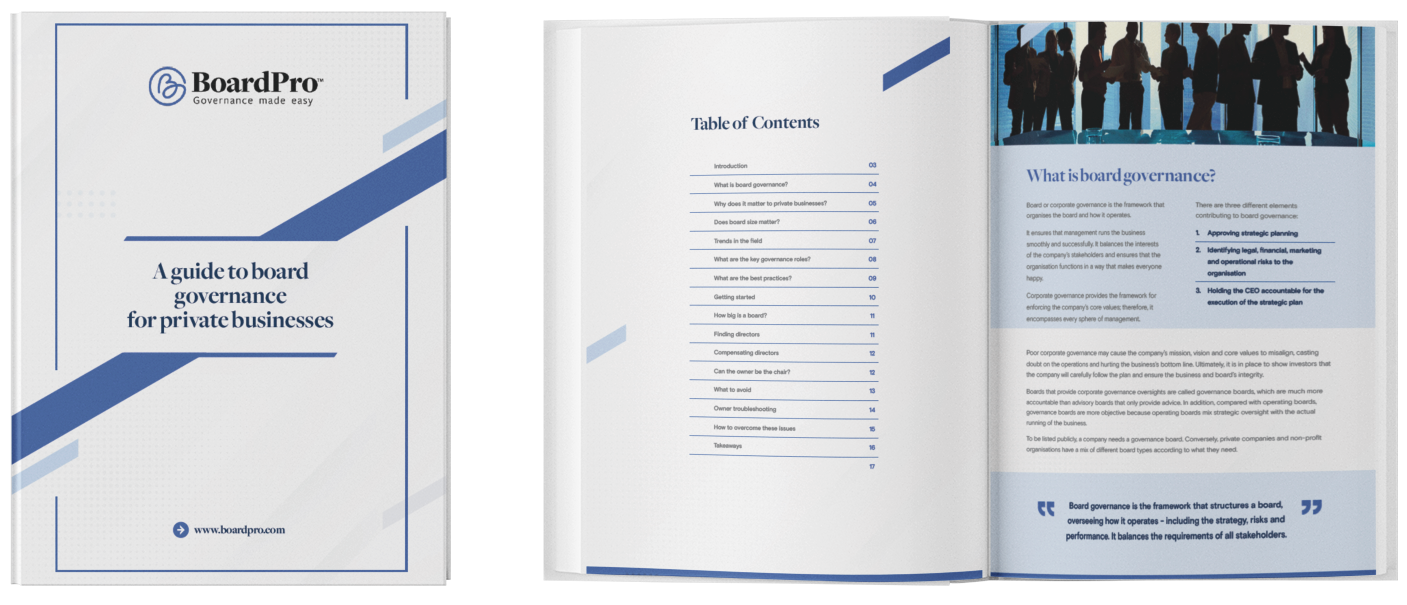How good governance works to manage business risk
A key component of identifying and managing risk is good governance in business practices. If an organisation is practising good governance at all levels of its operation, it will be equipped to protect themselves from financial, operational and reputational risks. In addition, established policies and procedures can help insulate them against future risks.
It is not possible for you to eliminate risk entirely as an organisation – it is, after all, a natural part of the business world! However, you can learn to live and work with it effectively. Good governance practices ensure future failure and help mitigate risks that occur, despite our best efforts. Senior managers are responsible for implementing good governance policies by clearly outlining company goals, appointing and managing directors, providing training and communicating effectively.
Good governance procedures and policies also need regular monitoring to keep them up to date. Companies should regularly review their risk management protocols to ensure they are up to date and aware of current risks in the industry (and world). Risk management strategies should contain important information such as accurate company statistics, easy-to-follow instructions for crisis management and comprehensive oversight and compliance systems.
How good governance can be used to manage risk
Used correctly, good governance can provide a framework to manage risk. It helps companies assess and mitigate risks to their growth and future stability. By setting clear precedents for company performance standards, stakeholders’ roles and regulation compliance, good governance keeps companies honest and on track to meet their goals sustainably. With technology expanding business opportunities and overhauling the field, good organisational management is more important than ever.
Companies should strive to insure themselves against future potential risks (such as misconduct or unforeseen events). Operating under the framework of good governance can help them identify such risks before they are an imminent threat to the company. That way, they can plan ahead and make informed decisions when the risk arises. Good governance should also guide executive leaders in their decision-making, with the aim of encouraging company-wide transparency.
Good governance is key when it comes to company oversight and the maintenance of economic growth within an organisation. In this way, it is in the best interest of the company – and it prioritises the goals of the company’s stakeholders, too!
Good governance in practice
All companies should strive to operate under a good governance framework. This is by far the most effective and efficient operational strategy, particularly if you are a large organisation. Good governance includes standards such as accountability, transparency and clarity – all of which make employees across the organisation more risk-aware and savvy. Giving everyone access to succinct, comprehensive information allows the team to make informed decisions and effectively anticipate and manage risk. Planning ahead with risk mitigation strategies helps companies reduce their overall risk levels and access their full potential in a smooth, sustainable manner.
Good governance also promotes tighter internal control within an organisation, as it creates clearly defined expectations for all roles within the team. Companies operating under a good governance framework report increased efficiency and higher profit margins. When every team member is clear on their personal responsibilities, as well as their role in the overall functioning of the company, crises that arise can be dealt with in a calm, collected way. No more confusion over who is responsible for what. With straightforward guidance, every employee can respond appropriately and work together to mitigate risk. In this way, good governance promotes accountability and increased personal and collective responsibility.
How to spot risk
Even if you are a good governance veteran, it can be challenging to identify risks before they are an imminent threat to your organisation. Knowing how to spot them and what to do once you determine that there is a risk can make all the difference in the direction of your business. Assessing potential risks ahead of time is an important leadership skill, as it reduces the impact of said risks on the company’s future. One such example would be companies maintaining an awareness of currency and interest rate changes in order to anticipate any possible financial risk. Other strategies might work to anticipate operational risks, such as equipment malfunctions, or to guard against human error.
The next step after identifying risk in leadership is knowing how to act and dealing with the risk head-on. Whatever action you choose to take as a leader should be directly proportional to the size of the risk. You may take steps such as establishing safeguards against the situation or reallocating resources to manage the risk.
If, say, a company that was monitoring currency fluctuation spotted a financial risk, it could take steps to decrease this risk to its success by hedging its exposure and investing in other companies and currencies. Other safeguard measures could include increased safety protocols and training programs for team members.
Communication is key
Good governance sets the standard of good business practice. It includes the rules that manage business entities and is a crucial part of effective risk management and leadership. Transparency and communication should be at the forefront of all good governance practices, and company leaders should work to implement these values at all levels of their organisation. This has the added benefit of making sure that stakeholders understand business operations and that their priorities are being held in the highest regard. Clarity in the decision-making process is key for both stakeholders and leadership. Avoiding miscommunication is one easy way to dramatically reduce the risk of misunderstandings and conflict between team members.
If a business hopes to succeed, it needs to prioritise communication and transparency of practice. Corporate governance relies on these two factors in order to function effectively. Clear communication from the leadership team builds confidence in their ability and promotes adherence to company policy. Building trust between stakeholders, customers and shareholders is a key part of practising transparency.
If, for example, your company is part of a merger or acquisition, you must keep all stakeholders informed throughout the process. They should be empowered to exercise their decision-making responsibilities in full. As such, they must have access to all the information necessary to make informed decisions and anticipate potential company risks. Overall, all members of the team should have a clear sense of their role in the transfer and be able to fulfil their duty.
Reducing risk through good governance
No matter the size of your organisation, good governance practices are essential when it comes to reducing risk. Risk management is a direct result of effective governance. By operating under a good governance framework, your team can learn to efficiently detect and deal with risk, protecting the company in the long run. Good governance includes clear rules and procedures decided upon prior to moments of crisis that outline decision-making policies, define management strategies and delineate roles.
Operating under good governance is a continuous process. Whether you are just beginning on your governance journey or an experienced company, consider implementing some of the strategies discussed above in order to manage organisational risk. Good governance practices have been shown to increase company success, improve decision-making amongst leadership and increase team confidence in shared goals.

Download our latest guide - A guide to board governance for private business
If you're looking for a tool to streamline your Board processes, check out BoardPro - an all-in-one software solution designed specifically for Boards and busy CEOs!
Schedule a demo with our team today and begin to experience a whole new way of meeting.
Share this
You May Also Like
These Related Stories
.png)
Cybersecurity in governance: what a director needs to know

How to conduct effective strategic risk reviews



